Construction machine vote welcomed
11 October 2018

Amendments calling for the inclusion of construction machinery in the scope of the Clean Vehicles Directive have been rejected by the European Parliament Environment Committee.
The Committee was voting on the proposal to amend Directive 2009/33/EU on the promotion of clean and energy-efficient road transport vehicles, known as the Clean Vehicles Directive.
CECE (Committee for European Construction Equipment) said it was glad about the decision, saying that this was in line with CECE’s arguments and awareness-raising over recent weeks and months, since the emergence of this debate in the European Parliament in June 2018.
CECE secretary general Riccardo Viaggi said, “We have no reservation on the emission reduction goals the EU has set itself and the construction machinery industry is proud of the significant advancements it has made in this regard.
“However, the Clean Vehicles Directive is tailored to the transport sector and is not an appropriate instrument to cover mobile machines such as those manufactured by CECE member companies.”
He added that CECE thanked the MEPs who voted these amendments down for “sensible and responsible policy-making” and said he looked forward to working with all MEPs and demonstrating CECE’s contribution to more sustainable construction processes.

Viaggi said it was interesting to note that, in spite of support from a wide spectrum of political groups, Compromise Amendment 5 – which was considered a back-up plan for the proposers of construction equipment’s inclusion within the CVD’s scope – was rejected by a very close vote.
He said that if it had been carried, the amendment would have introduced a review clause, obliging the European Commission to assess the inclusion of construction machinery during the review of the CVD, two years after its entry into force.
The CECE view is that it is fundamental to issue a reminder that construction machinery works as part of a variety of different processes and is not intended to carry people or goods from A to B.
“Therefore, construction equipment cannot and will not be considered as road transport such as passenger cars, buses, coaches and trucks.”
With regard to electrification in worksites, CECE said that the different situation for recharging infrastructure, and limitations on the electrical supply to support the use of purely electrical machinery – on very different power ranges – had to be clearly distinguished from road transport.
Viaggi said that CECE would continue to monitor the developments in light of upcoming trialogue negotiations between the European Parliament, the Council and the European Commission, knowing that the European Council had never shown any interest in including construction machinery into the scope of the CVD.




